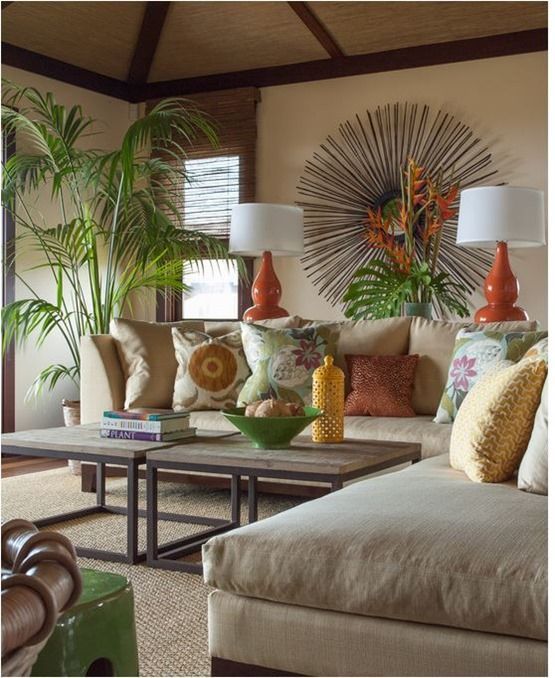Okikiko.com – Tropical interior design has grown in popularity over the years, but many people still don’t understand exactly how the design style works. A tropical interior layout can be developed using the same soulful blend of elements used in other interior design styles. One way to create a tropical interior design is to consider what you hope to experience in a tropical locale. Are you more picturing warm ocean views, spectacular palm trees, vivid sand dunes?
Use of Dense Trees in Tropical Interior Designers
Or do you picture lush tropical vegetation covering every square inch of your home? Either way, the primary element in tropical interiors is the use of heavy, lush tropical flora. This can include palms, bougainvillea, orchids, or any other type of tropical plant you like. When used in tropical interiors, these plants can have a major impact on the overall style of the design. Palm trees will often dominate an entire room, with furniture being placed against the backdrop of dense foliage. The use of furniture and accents that are bold in nature will help to break up the solidity of the palm trees.

In addition to the use of heavy, lush foliage, tropical interior designers often consider the textures and patterns of the materials involved. Often times, textures like brick or stone are used to create an image source for the various textures and patterns. By using a different texture for each room, the tropical interior designer helps to soften and define individual scenes. The use of textures and patterns may even lead to the use of unusual colors for the walls, depending upon the image source and desired effect.
Large Furniture Becomes a Characteristic of Tropical Interior
Another way that textures and patterns are used in tropical interiors is through the use of furniture. Typically, a tropical room will contain a large sofa, love seat, accent table and accentuated by tropical-themed pillows. The use of furniture in tropical interiors is usually on the large side, as most furniture in tropical interiors is very solidly constructed. This allows for the placement of larger pieces of furniture around the room, including chairs and loveseats. However, even a small sofa in the corner of a room can lend itself to using cushions or throw pillows on the seat to create visual interest in the area.

Lighting is also an important consideration in the design of a tropical paradise. The use of bright, natural light has long been considered a necessity for creating a tropical interior. Although this may be true, the type of lighting utilized should also be in line with the particular effects desired. For example, wall fixtures that are constructed out of wood with glass embellishments are considered to be highly elegant, whereas a different style wall fixture that is made of iron is considered to be more rustic and earthy.
Collection of Tropical Plants Like Bamboo in the Greenhouse
Because the interior is typically smaller than other rooms, attention to detail is key. For example, window treatments such as curtains should include strategically placed blinds or other types of shutters so that sunlight can adequately reach the interiors. Similarly, use of textures such as plush rugs on the floors help to add to the overall feel of a tropical home. These should be chosen in complimentary colors and patterns, so as not to overpower the natural elements.
In the case of bamboo, the native species are known for their sustainability and the ability to grow extremely well in a variety of climates. Bamboo is used extensively in the construction of tropical houses and floors, but it can also be grown in hydroponic systems, allowing it to be both a natural element and a staple in a tropical plant collection. Some of the more common species are found in tropical plant collections such as those that are grown in greenhouses. These can provide a range of benefits, including the production of bamboo textiles and other products, and the planting of tropical plants and trees.

The use of lighter colors and subtle earth tones is a popular approach to designing the tropics. These schemes generally set the scene for tropical safaris or water trips, and when combined with complementary items such as bamboo or rattan furniture, they provide a tranquil, idyllic image source for the interior of the home. Alternatively, darker shades of brown and charcoal give a similar feel and can also help to soften the dramatic effect of the lighter hues. With a combination of these different color palettes, designers have the chance to create an image that is both striking and relaxing at the same time.


